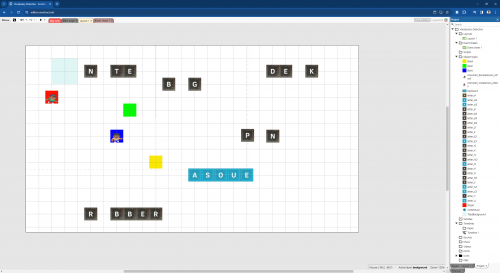Level 4-Reflect on Digital Design Process: Vocabulary Detective Game Design

(Fig. 1 Vocabulary Detective. Designed and Created by Yupei Duan and ChatGPT )
While studying Level 4 of the Designing Games for Learning course, I have been reading the book Reality is Broken: Why Games Make Us Better and How They Can Change the World, written by Jane McGonigal (McGonigal, 2011). There were a lot of ideas in the book that needed to be pondered during designing serious games. During the process of designing my game on Construct 3, I have been pondering this idea from the book, “a game designer and researcher should be aware that video-games are not just entertaining and addictive but also can be powerful tools for solving real-world problems.” Life is full of problems. Learning a new language is one of them that I am resolving in my real life.
In my family, there is a daily online activity hosted by my elder daughter starting from December of 2022 to now, every night, the little girl teaches English words or sentences by leaving voice messages in a social media group where I, my wife, my parents, and my parents in law will receive the messages and learn the relative content, then respond to our own English reading practice via sharing voice messages in the group. A virtual online platform unites all the family members together with doing this simple activity. How can I make this activity more interesting? How about designing a video-game based on this online activity?
When I started to design my game on Construct 3, the initial idea was to make a bilingual vocabulary game to let the players (like my daughter, my parents and parents in law) can play the game to review the vocabularies they have learned. However, just matching the right translation to the expressions is hard to reach some high-level instructional objectives. While checking the English Language Arts (ELA) Priority Standards (Priority Standards – English Language Arts, n.d.), I found there were very clear expectation to the students’ understanding of vocabulary:
- Using sentence-level context to determine the relevant meaning of unfamiliar words or distinguish among multiple-meaning words
- Distinguishing the literal and nonliteral meanings of words and phrases in context
- Using conversational, general academic, and domain-specific words and phrases
In the coming year, my elder daughter will go to 3rd grade in Columbia’s local primary school. Why don’t I design a game for her to warm up for the upcoming school year English vocabulary learning? At the same time, other family members will be familiar with my daughter’s learning content. So, I changed the educational goal of the game from simple translation to resolving crossword puzzles.
Reflect on your process for designing the mechanics for your game.What worked best, what didn’t?
During the process of designing my game, I found the following mechanics worked best for me:
- Points: the player can see the real-time points from the game.
- Storytelling and Narratives: an introduction scene will show in the beginning of the game to tell the background of the game. During the game playing, the player will compete with the villain to finish resolving the crosswords puzzles. At the end of the game, the player will see the result of competition with the villain.
- Feedback Systems: the player will hear the sound and see the effect diagram when the puzzles are resolved.
Some mechanics I wanted to use but failed, for example: badges and achievements, leaderboards, collaboration and teamwork, etc.
If you had to do this process over again, what would you change? If nothing, why not?
If I had a chance to redesign the game, I would like to delve deeper into the ELA Standards in Missouri first, then to find more proper content to design the game. Besides that, I would like to read more game-design papers related to ELA learning. Based on recent research progression, I would design a higher value educational game.
What did you learn from the Construct 3 implementation aspect of the project?
Currently, I am still a novice user of Construct 3, the more tutorial videos I watch, the more potential functions of Construct 3 I can find. I think it’s a friendly and convenient game design platform, in which the users can design games on chrome. The design technologies are based on coding logic but don’t need the designers to have high coding skills to start.
How has this game design process differed from your previous game design experiences?
Compared with Twin, an open-source tool for telling interactive, nonlinear stories, construct 3 contains more dimensional interactions with the players. More real-time feedback could be easily fulfilled in Construct 3, like animations, interactive effects, etc, which would be hard to have in Twin.
Digital Game Details:
- Game title: Vocabulary Detective
- Subject area: English Language Acquisition
- learning objective:
- After playing the game, the players will be able to correctly spell the given English words.
- After playing the game, the players will be able to match the right graphics with the relative English words.
- After playing the game, the players will be able to compose a sentence using the given English words.
- Game goal: learn and review english words; practice composing English sentences.
- Core dynamic: Race to the finish, and Matching.
- Mechanics: Points; Storytelling and Narratives; Feedback Systems.
- Assessment : The game system will evaluate the players on their speed and accuracy when they successfully finish all the right matchings.
- Scoring: The initial score is 100 points. Each correct word matching will add 10 points, and each correct sentence matching will add 20 points. Meanwhile, each wrong matching will reduce 10 points.
- Reward: The players will start from the game with a 120 seconds back counting timer. The left time will be calculated as extra points, each second equals to one point, to add to the score. The more proficient the player with matching, the higher points the player will get. The top 3 achievements will be recorded and will be viewable to other players.
What is the core loop you want players to experience in your game?
The player will control a detective (sprite 1) to use the clues (English nouns) to resolve the crosswords puzzles and match the relative graphics, then use the words to compose an English sentence as soon as possible. Each correct match will add the score.
Show off your Prototyping!


Fig 3. Working progression 2 on Construct 3
Peer responses
What did your peers have to say about your game design?
Comments from Dr. Oprean:
Bilingual Detective is an exciting title, Yupei. For your intended learning objectives, I am not seeing either one as being entirely higher-order. Translate can be closer to higher order but it generally falls into lower-order by itself. Maybe what players do with the translation activity would make it higher-order? For reference, the following chart may be helpful – https://tips.uark.edu/blooms-taxonomy-verb-chart/
You have a lot of nice elements in this game idea so far, though I wonder if you could contextualize those elements a bit more so there is continuity between them that makes it easier for the player. Such as the Timer – why is there a Time Element for this? The element should connect with something related to the game goal and context – maybe something along the lines of being a detective and needing to resolve a clue before the villain gets away?
The translated word matching is a nice mechanic. I would think there should be some devising involved given the detective context though. Something like putting the translated words together to determine who the thief or criminal/villain is? This would change the core dynamic slightly but that is something to consider.
Could the scoring also be something that is more contextualized with a detective game? Such as clues solved or tracking the progress of decoding the information (which may still use the same scoring system you indicated).
For the prototype, a shooter game is an interesting idea and not one I would have thought of for a detective game. I would want to see something beyond changing what players shoot from the Ghost Shooter tutorial as well – so perhaps that is where you can consider what about the game makes the player a Detective and see if you can demonstrate some (not all) of that in one round of the game.
You are off to a good start here and I’m looking forward to seeing where your idea goes.
Comments from Leeann Grace:
- What did you like about the idea?
I like the idea of Bilingual Detective, as it combines language learning with gamification, making the process more engaging and interactive.
- What suggestions do you have for them to improve the idea? (this can be in many forms including providing any resources you may have found that would be helpful in prototyping!)
Diversify Learning Modes: Consider incorporating different learning modes, such as auditory and visual cues, to accommodate various learning styles.
Progressive Difficulty Levels: Implement a system where the difficulty level increases as the player progresses, keeping the game challenging and ensuring a continuous learning curve
- Does the assessment appear to test the learning objectives?
Testing Learning Objectives: The game seems to effectively test the learning objectives related to matching English nouns with graphics and translating English sentences into Chinese. The speed and accuracy metrics align well with the language acquisition goals.
- What comments do you have on the scoring and rewards as motivating the player to keep playing?
Feedback on Scoring: Include a detailed breakdown of the score, specifying points earned for each correct match and deductions for incorrect ones. This transparency can help players understand their strengths and areas for improvement.
Were there any useful suggestions to help you move forward?
Both Dr. Oprean and my classmate Leeann gave me very valuable recommendations. Based on them, I have been improving my game development and design documents. The comments about designing teaching objectives from Dr. Oprean helped me think how to design a challenging and educative game, but not only a simple and funny game for the players (learners). After checking some papers about designing games for ELA learning, I found it was a huge research area. I am still on the road.
Like a hangman game showed that Hangman Game can improve the students’ understanding of the meaning of the words, besides that the students also can master the words based on the context given. It also helps a lot with the practice of vocabulary and spelling in children. The game exposes students to practice the alphabet and remember the vocabulary learned in classes. From this paper (Martono et al., 2013) I understood that time limitation is a very important game mechanic.
Flashcards have always been very useful when teaching children interactively. In the article the author writes about the benefits of GBL in children and states that GBL is known to sharpen the memory of kids by 90% and also says that Learning concepts through visual learning leads to better retention power and sharpens the minds of kids, which allows them to improve their memory. Using cards in the classroom as competition will awaken in children the need to play and win. Some elements from the article (Why Game Based Learning Will Make Your Child Smarter?, 2020) I would like to use in my game design in the future.
References
Priority Standards—English Language Arts. (n.d.). Retrieved November 30, 2023, from https://sites.google.com/view/priority-standards-mo-dese/home/english-language-artsWhy Game Based Learning Will Make Your Child Smarter? – EdTechReview. (2020, July 23). https://www.edtechreview.in/trends-insights/trends/why-game-based-learning-will-make-your-child-smarter/
